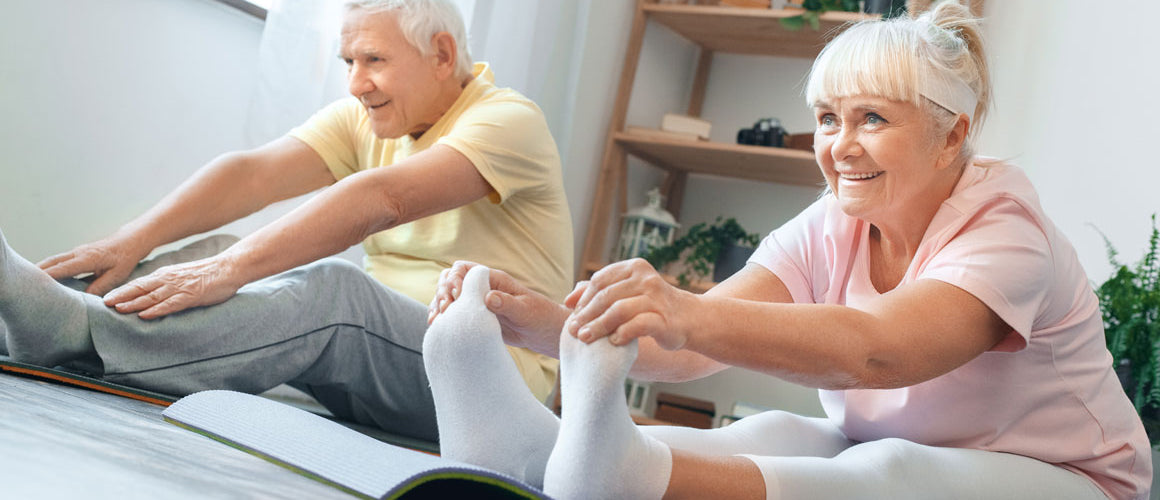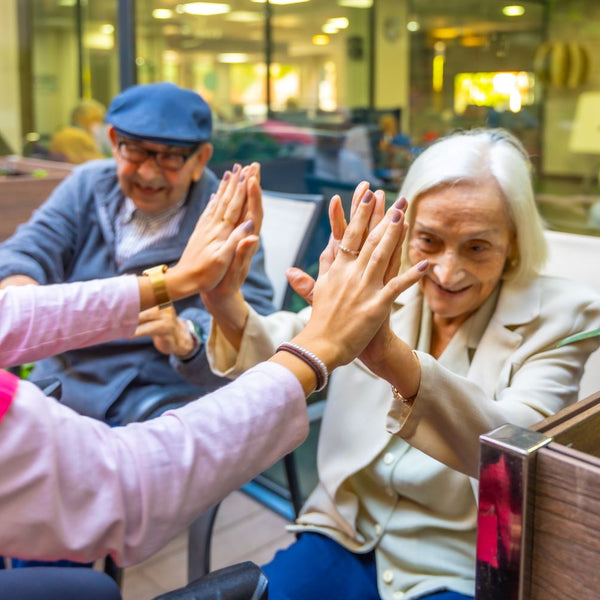Estimated reading time: 4 minutes.
Exercising when you’re older doesn’t have to involve running marathons, going to spin classes or swimming the length of the English Channel.
Instead, it’s about keeping the body moving, even if those movements are small or for a short period of time.
You can find some exercises that may be useful to you later on in this article, but first, what are the benefits of exercising?
Improved lifespan
Exercising regularly could help you to live longer. According to the World Health Organisation, physical inactivity can shorten your lifespan by three to five years. The organisation states that exercise is a subcategory of physical activity and is something that is structured, planned or repetitive.
Physical activity also includes movement that is done during your leisure time or as a means of transport. For instance, gardening and cycling to work would come under general ‘physical activity’, whereas weight lifting would be considered specifically to be exercise.
Developed muscles
It’s not that you’re going to turn into Popeye or Arnold Schwarzenegger overnight, but regular exercise can improve your muscle strength, which has all kinds of benefits in itself.
As people age, the amount and the size of their muscle fibres decreases. However, it’s not been proven that this is solely due to aging - lack of physical activity has something to do with it too. Therefore, the more you exercise, the better your muscle mass could become.

Enhanced balance
Exercising can improve both your muscles and bone density. In turn, these things will help you to balance more easily. However, balance is something that will come in time and you may, at first, feel a little unsteady. This is why it may be important to have someone there when you first start increasing the amount of physical activity you’re doing.
Alternatively, you could wear a personal alarm pendant with elderly fall alert technology or personal alarm watch while exercising. Should you fall or hurt yourself, you know that you can easily get assistance. These devices come as both a wrist pendant and an alarm necklace, so pick whichever you feel would be more comfortable to wear.
After a short time of regular activity, it’s likely that your balance will get better, giving you the confidence to continue your exercise. Exercises that help to improve balance include tai chi, walking heel to toe or standing on one foot. If you try the latter, ensure that there is a chair or other tall object nearby to use should you overbalance. You may even wish to start off with some seated exercises, which can also help improve mobility.
Reduced risk of stroke or heart attack
Any kind of activity that increases your heart rate will boost the blood flow to your heart and other organs in your body. Some vigorous hoovering or gardening could therefore reduce your chances of having a heart attack or stroke
What are the benefits of exercise on the brain?
Exercise doesn’t just have an impact on your physical health but your mental wellbeing and health too. Regular exercise that increases your heart rate can enlarge the hippocampus in the brain. This is the area of the brain that stores memories and information. When you learn something new, a pathway is created. When you revisit this information, the pathway that was formed becomes stronger. By increasing the size of the hippocampus, you may find that your memory improves and your chances of suffering dementia decrease.
Not only this, but exercise can reduce the amount of stress hormones in the body and increase the amount of serotonin. While this is a physical reaction, many people say that they feel happier and calmer after doing an activity.

How to exercise over 60
When you reach the age of 60, the recommended amount of exercise is 150 minutes, or two and a half hours, per week. It’s completely up to you how you decide to split this activity.
For instance, you could do a small amount per day five or six times a week, or you might prefer to do a longer session just twice a week. Whatever you decide, the activity you do should be of moderate intensity.
What is the best exercise for the over 60s?
Every person is different, so for example, one 65 year old may feel more able to do an activity than another person of the same age. Only you can know your body and what you feel comfortable doing. The activities listed below might give you some inspiration when planning your fitness routine.
To build strength, you could use light weights to try exercises such as arm curls, lunges and leg pushes. If you’re unsure about using weights, resistance bands can also be used. Arm curls, also known as bicep curls, involve holding a light weight in each hand and lifting one at a time towards your shoulder while keeping your elbow pointing down. Lunges involve holding a dumbbell in each hand while taking a large step forward, so the rear leg is bent at the knee, before returning to an upright position.
These type of exercises can easily be done at home and are a great way to stay in shape throughout the colder months and during lockdown.
If you’d prefer to do something that involves moving rather than lifting, you could try a brisk walk or go on a short bike ride. If you take your family with you, current guidelines say that you can exercise with one member from another household (if you are not shielding), so this is a good opportunity to make these things a social as well as a physical activity.

For those that prefer the water, you could try completing 10 lengths in a swimming pool or taking up a water aerobics class once it is safe to do so.
Exercising in water is easier on the joints, which may be important if you find your knees or elbows get sore when walking or lifting light weights. Water aerobics is also great for increasing your muscle strength.
If you enjoyed playing football when you were younger then consider walking football. It's the same game played at a slower pace.
Sitting exercises
The NHS recommend sitting exercises to improve strength and flexiblity. These can be done at home to improve mobility and prevent falls.
You will need a solid chair that does not have wheels. Try carefully building up the repetitions over time and combining them with other routines:
- Chest stretch: this is good for posture by pulling your shoulders down and chest out.
- Upper-body twist: this stretch will develop and maintain flexibility in the upper back.
- Hip marching: lift your legs with your knee in a sitting position.
- Ankle stretch: by improving ankle flexibility you can lower the risk of developing a blood clot.
- Arm raises: build shoulder strength with arm lifts.
- Neck rotation: slowly turn the head from side-to-side to improve neck mobility.
- Neck stretch: to loosen tight neck muscles.
Read the NHS sitting exercises.
Resources for healthy living
You may also be interested in these other advice guides from Taking Care:


